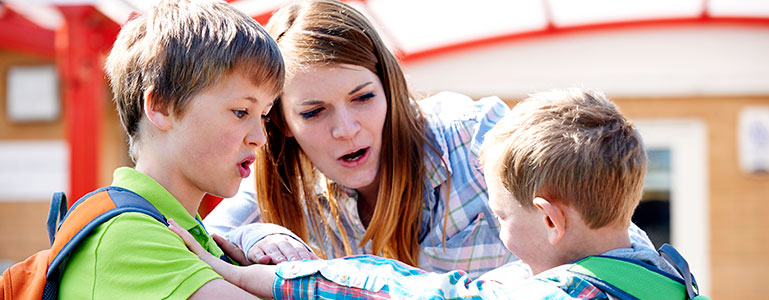Conflict resolution and problem solving are two of the most important skills we can teach our children. Think about it … Being able to work out a problem with a peer and come to a reasonable resolution is something that helps us in work and personal relationships throughout our lives.
Tips To Help Children Problem Solve
Here are few tips to help you teach problem solving skills with children starting as young as three years old. Taking a little time to follow these steps will translate into much less time bickering and fighting and more time to do the fun things. Not only that, but you will be teaching skills that will last a lifetime and help your children and students be successful in the future!
Step 1—Neutralize the situation
If anyone is hysterical or has been hurt, the first thing you must do is to help them calm down and feel better. No one can problem solve when they are hurt or emotional. You may also need to remove the source of the conflict temporarily until the problem in solved. If two children are fighting over a toy for example, say I’m going to hold this while we work this out. If a child has lost control and resorted to physical aggression, he/she may need to be removed from the situation and given some time to cool off. There may also need to be a consequence for the aggression, but it is still very important to come back to solve the problem. If you don’t solve the problem the conflicts will just keep happening.
Step 2—Gather data
When both children are calm and ready to talk, listen to each of them tell you what happened from their own point of view. If a child is too young to explain well, it is fine to do some paraphrasing for them. Make sure both children feel heard by you and by each other. Don’t think about where to lay blame for the conflict, but rather how to solve the problem. Here are some helpful questions to use:
What happened? How did you feel when you…? How did you feel when your friend/sibling…?
Why did you …? What happened then?
Step 3—Define the problem
Often children have misinterpreted what their friend was trying to accomplish and it is easier to solve the problem when you all understand what really happened. State the problem acknowledging both, or all the children’s needs. Here is a suggestion for what to say:
It sounds like you wanted to … and you wanted to … What should we do so that everyone can be happy?
Step 4—Generate lots of ideas
Help the children think of as many ideas as possible. Don’t pass judgement on the feasibility of the ideas at this step. The real benefit of this step is the ability to think of alternatives. Remember to:
Write down the ideas—it makes it feel more important to the kids.
Encourage different ideas.
Focus on the children’s ideas, but if they are young, it is okay to give some suggestions.
Review the problem to help the children stay on track.
Step 5—Evaluate the ideas
Ask the children what they think might happen if they choose a specific idea or another. Let them know if you think an idea is unsafe or really inappropriate, but resist passing judgement based on your own sense of fairness. Ask the kids to think about if an idea can really work for everyone. If no ideas seem to be acceptable for everyone, talk about how to change an idea to make it more acceptable.
Step 6—Decide on an action plan
List all the alternatives that are being considered. Remember that we need people who are happy to compromise or even give in occasionally. If you are worried that one child is being intimidated or taken advantage of by a more strong-willed child, check in with the more accommodating child.
Say something like: Are you sure it is okay with you to do it this way? You don’t have to let him/her have it her/his way. Or Does this really work for everyone?
If all the children are really okay with a plan—even if you don’t think it is entirely fair, let it go.
Follow through to make sure the children stick to the plan. Even if it seems like they might not care anymore, check in and make sure they know that the follow through is available to them. For example, if children decide to take turns with a toy and by the time it is the second child’s turn, he/she is busy doing something else, it is still important for the first child to offer the toy. If you don’t have that follow through the kids will lose faith in the process.
Be sure to congratulate the children for solving the problem!
You may be thinking, How can I possibly do this with every single little conflict my children get into? It must take so much time and we have to keep on schedule and can’t stop everything to do this all the time!
Believe me, I realize that you can’t do this for every situation, every day, but I promise that the more you do it, the better your children will get at doing it, the faster they will resolve their conflicts, and the fewer big upsets they will have.
Stephanie Agnew is the Assistant Director of Parents Place on the Peninsula. She can be reached for consultation on this and many other topics by calling 650-688-3046 or emailing her at [email protected].

